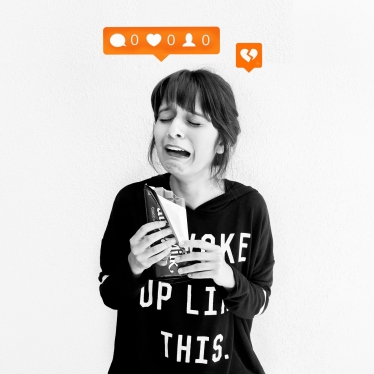You know how sometimes you mistake temporary bliss for the forever kind? And temporary people for the front porch, laughter-lines-and-wrinkles, reminiscing-when-you’re-seventy kind?
And you’ve become Taylor Swift, only devoid of all musical capabilities and snarky backlash?
So you spend your time pathetically staring at your phone because you think that if you concentrate hard enough it’ll ring, and if you just give it time, things will change and you’ll be able to listen to someone other than Adele. But then you grab your phone and you start typing:
“Hey, I know it’s late, but I just wanted to say NEVER MIND I’LL FIND SOMEONE LIKE YOOOOOOUUU!!&*$#!!!*!”
As unlikely as it may seem in that moment, let me tell you, you will… sort of. You see, love isn’t always a well-dressed man with perfect hair; sometimes love is a tall, dark and handsome slab of chocolate.
So you drop your phone in obvious shame, and slowly make the transition into rock bottom. You reach for the chocolate milk tray, stuffing your mascara stained face, sinking deeper and deeper into the surrounding chocolate wrappers.
But it’s not necessarily a bad thing that you crave chocolate in times of crisis. It can actually combat feelings of sadness, and to some extent, mend your broken heart.
In an experiment conducted by Michael Macht and Jochen Mueller, the consumption of chocolate proved to improve emotional and depressive states. The experiment had participants view sad video clips to induce a particular depressive emotion. Once induced, participants were given either a glass of water or a piece of chocolate to improve their mood. Results showed that those given chocolate felt significantly better afterwards, as opposed to the other participants.
We can understand the change in mood specifically in terms of chocolate’s carbohydrate ingredients, amino acid tryptophan, and its production of serotonin. It’s no secret that carbohydrates make us feel good. Our body changes carbohydrates into blood sugar and sugar quite often signals the brain to produce serotonin. ie. the feel good hormone.
According to an article by Medical News Today, serotonin is a neurotransmitter responsible for balancing mood. Through a complex conversion of tryptophan, serotonin is produced to signal the brain to improve mood, sexual desire and other body functions. So without the proper signaling to the brain, we’re often left feeling disorientated. Researchers have linked depression to a lack of serotonin within the system, so it makes sense that the consumption of foods able to produce serotonin can and will improve your mood.
So while you’re stretched out across the couch, staring at the phone waiting for a reply, you can and should eat. Eat and eat and eat your feelings until it hurts just a little less.
But it’s not about the craving for sugary foods; its simply about feeling like you have the ability to stretch your lips from one cheek to the other.
Smiling can be made easier by chocolate, more importantly, by the kinds of chocolate you eat. Dark chocolate. ie. chocolate with 35% or more cocoa, tends to contain more tryptophan to increase serotonin, where as other milk chocolates, diluting the cocoa content, combats the feel good effects of consumption. Sure, sugar gives you a temporary boost, but once it wears off, once it leaves you, the pain you felt when he left, hits you all over again. So instead of reaching for that milk tray, go for the 70-85% Lindt chocolate. As soon as those blocks melt in your mouth, the emptiness inside you will too.
Maybe I’m an idealist, but I think chocolate can replace your boyfriend.
Dr Owen, a scientist studying the effects of chocolate on the brain, indicates through multiple scans that when eating or simply smelling chocolate, the orbifrontal cortex, an area of the brain associated with pleasure, glows.
So why text a man you’re not sure wants to be with you when you can hop into your car to your nearest Caltex for a slab of chocolate just waiting for you to undress him?
Am I placing too much value on chocolate? Maybe. But are you placing too much value on someone who can easily be simulated by cocoa beans and is not placing enough value on you? Definitely.
Chocolate has all the properties your boyfriend has: its able to make you feel good and improve your mood, it can induce feelings of pleasure, and is dark, sexy and smooth.
So stop crying, put down the phone and undress the contents of your new bae.
Pour Nutella into the cracks of your heart, and believe in the inevitability that the broken pieces will stick back together again.
And if you must send a follow up text, at the very least let it be along the lines of how you, are never, ever, ever, getting back together.



